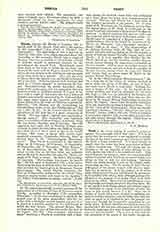

Thecla, SAINTS.—I. Thecla of Iconium, the reputed pupil of the Apostle Paul, who is the heroine of the apocryphal “Acta Pauli et Theclae” (cf. Apocrypha). Our knowledge of her is derived exclusively from these Acts, which appeared about 180. According to this narrative Thecla was a virgin of Iconium who was converted to Christianity and led to dedicate herself to perpetual virginity by the preaching of the Apostle Paul. Miraculously saved from death at the stake to which she had been condemned, she went with St. Paul to Antioch in Pisidia where she was thrown to the wild beasts and was again saved from death by a miracle. After this she went to Myra where the Apostle was, and finally to Seleucia where she died. With the consent of St. Paul she had acted as a “female Apostle” in proclaiming the Gospel. Notwithstanding the purely legendary character of the entire story, it is not impossible that it is connected with an historical person. It is easy to believe that a virgin of this name who was a native of Iconium was actually converted by St. Paul and then, like many other women of the Apostolic and later times, labored in the work of Christian missions (cf. Harnack, “Die Mission and die Ausbreitung des Christentums in den ersten drei Jahrhunderten”, 2nd ed., I, 295; II, 58). In the Eastern Church the wide circulation of the Acts led to a great veneration of Thecla. She was called “Apostle and protomartyr among women”. Her veneration was especially great in a number of Oriental cities, as Seleucia where she was buried, Iconium, and Nicomedia. Her cult appeared very early also in Western Europe, particularly in those districts where the Gallican Liturgy prevailed; there is direct proof of this in the fourth century. Her name is given with various topographical comments (Nicomedia, Seleucia, Asia) on several days in the “Martyrologium Hieronymianum”. Thus Thecla is mentioned in this martyrology on February 22, February 25, September 12, September 23, and November 17 (“Mart. Hieron.”. ed. de Rossi-Duchesne, 24, 36, 120, 124, 144). It seems certain that on all these dates, and probably also on 20 and December 21, the same St. Thecla, the pupil of St. Paul, is meant. In Bede‘s Martyrology (cf. Quentin, “Martyrologes historiques du moyen Age”, 93) her name is mentioned with a brief notice taken from the Acts on September 23, the same date as that on which her feast is given in the present Roman Martyrology. The Greek Church celebrates her feast on September 24 and gives her the title of “Protomartyr among women and equal to the Apostles” (cf. Nilles, “Calendarium utriusque ecclesiae”, I, 283 sq.).
II. We possess historically accurate accounts of the martyrdom of a Christian of Gaza in Palestine named Thecla. According to Eusebius (“De martyribus Palestinen.”, 3) she was condemned to death in the second year of the great persecution (304-05) together with a Christian named Agapius and was torn to pieces in a horrible manner by the wild beasts to which she was thrown. The present Roman Martyrology gives the feast of this saint under the date of August 19.
III. The “Martyrologium Hieronymianum” mentions a Thecla in connection with a Zosimus among the martyrs whose feast was celebrated on June 1; these two saints were commemorated at Antioch. Whether this Thecla was a local saint of the Oriental metropolis is not known.
IV. A catacomb of St. Thecla on the Via Ostiensis, not far from the burial place of St. Paul, is mentioned in the seventh-century itineraries to the graves of the Roman martyrs. A church stood on this spot on a hill over the catacomb where the body of the saint rested. St. Thecla must be regarded as a Roman martyr. Armellini believes that he has found the cemetery of St. Thecla (cf. Marucchi, “Les catacombes romaines”, Rome, 1903, p. 91 sqq.).
V. The Martyrology of St. Jerome mentions under May 31 (69), in connection with two martyrs buried on the Via Aurelia, a group of martyrs named Tertulla, Lupus, Justa, and Thecla. It is very possible that besides the St. Thecla buried on the Via Ostiensis another Roman female martyr bearing the same name was buried on the Via Aurelia. Still we have no further account of this group of martyrs, and just as little of a number of Roman martyrs, among whom the name of a Thecla also occurs, that are given under March 26 in the present Roman Martyrology.
VI. In the “Martyrologium Hieronymianum” (58, 78) a. long list of the names of African martyrs is given under the dates of May 10, 13 and June 14, and each time a Thecla is mentioned. Nothing further is known of this saint. In the legend of the twelve brothers and martyrs, Donatus, etc. (cf. Acta SS., September, I, 138-41), the parents of the brothers are called Boniface and Thecla, and these two are also given in the present Roman Martyrology as martyrs under August 30. Apart from the purely legendary Acts just mentioned nothing is known of them.
VII. In the “Acts of St. Hermagoras”, which are equally legendary (Baronius, “Martyr. Romanum cum notis Baronii”, Venice, 1609, p. 494) a St. Thecla of Aquileia is mentioned together with several other martyrs who are only known through this legend. Their feast is observed on September 3.
J. P. KIRSCH

